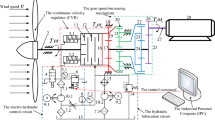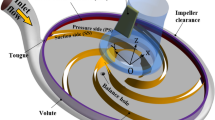Abstract
This paper presents the result and analysis of the composition of energy loss occurring in the hydro turbine. Two new types of energy losses, namely the hydraulic loss in the flow channel and the impact loss, are defined. All losses within the hydro turbine are divided into four types and the loss coefficients are defined accordingly. Expressions or characteristic descriptions of these losses as well as the calibration method of the loss coefficients are presented. Furthermore, the torque model of the hydro turbine where the inner energy loss takes place is established. The developed model has been used to calculate the power loss due to the mechanical friction generated by the units’ rotation to solve the difficulty of measurements of the mechanical friction loss in the hydro turbine. The definition of the impact loss explains the phenomenon that the loss of no-load is greater than that of the rated operation. A set of conversion coefficients are defined using the characteristic parameters at the rated operation, which are used to transform the parameters in the torque model into those that are easily measured. Therefore, the expression of the hydro turbine power is converted into a function that has the main servomotor displacement as its single variable. This makes the proposed model be convenient to use. Finally, the proposed model and methods are calibrated and verified using the measured data of a hydropower plant. Good agreement between the modeled results and the measurements indicates that the proposed model can represent the inner energy loss characteristics of the hydro turbine.
Similar content being viewed by others
References
Shen Z Y. Analysis of Hydraulic Turbine Governor System (in Chinese). Beijing: Water Resources and Electric Power Press, 1991
Fang H Q, Chen L, Dlakavu N, et al. Basic modeling and simulation tool for analysis of hydraulic transients in hydroelectric power plants. IEEE T Energ Convers, 2008, 23(3): 834–841
Oldenburger R, Donelson J. Dynamic response of a hydroelectric plant. AIEE T Power App Syst, 1962, 81(3): 403–418
Vournas C D. Second order hydraulic turbine models for multima-chine stability studies. IEEE T Energ Convers, 1990, 5(2): 239–244
IEEE Working Group on Prime Mover and Energy Supply Models for System Dynamic Performance Studies. Hydraulic turbine and turbine control models for system dynamic studies. IEEE T Power Syst, 1992, 7(2): 167–179
de Jaeger E, Janssens N, Malfliet B, et al. Hydro turbine model for system dynamic studies. IEEE T Power Syst, 1994, 9(4): 1709–1715
Kundur P. Power System Stability and Control. New York: McGraw-Hill, 1994
Quiroga O D. Modeling and Nonlinear Control of Voltage Frequency of Hydroelectric Power Plants. Dissertation of Doctoral Degree. Barcelona: Universitat Politécnica de Cataluňa, 2000
Keck H, Sick M. Thirty years of numerical flow simulation in hydraulic turbomachines. Acta Mech, 2008, 201(1–4): 211–229
Wang Y W, Wang Y, An Y R, et al. Aerodynamic simulation of high-speed trains based on the lattice Boltzmann method (LBM). Sci China Ser E-Tech Sci, 2008, 51(6): 773–783
Chen Z B, Jiang X, Zhou Z, et al, Progress in application of CFD techniques. Sci China Ser E-Tech Sci, 2008, 51(7): 827–841
Liu S H, Shao J, Wu S F, et al. Numerical simulation of pressure fluctuationin Kaplan turbine. Sci China Ser E-Tech Sci, 2008, 51(8): 1137–1148
Zhang L X, Wang W Q, Guo Y K. Intrinsic features of turbulent flow in strongly 3-D skew blade passage of a Francis turbine. J Hydrodynam-Ser B, 2007, 19(1): 92–99
Zhang L X, Guo, Y K, Wang, W Q. Large eddy simulation of turbulent flow in a true 3D Francis hydro turbine passage with dynamical fluid-structure interaction. Int J Numer Meth Fluid, 2007, 54(5): 517–541
Peng G Y, Cao S L, Masaru I. Design optimization of axial flow hydraulic turbine runner: Part II-Multi-objective constrained optimization method. Int J Numer Meth Fluid, 2002, 39: 533–548
Guo P C, Luo X Q, Qin Y C. Numerical performance prediction for a Francis turbine based on computational fluid dynamics stage simulation. Proc CSEE, 2006, 26(17): 132–137
Choo Y C, Muttaqi K M, Negnevistsky M. Modelling of hydraulic turbine for dynamic studies and performance analysis. In: Universities Power Engineering Conference, Australasian, Australia, 2007
Vournas C D, Zaharakis A. Hydro turbine transfer functions with hydraulic coupling. IEEE T Energ Convers, 1993, 8(3): 527–532
Hannett L N, Feltes J W, Fardanesh B, et al. Modeling and control tuning of a hydro station with units sharing a common penstock section. IEEE T Power Syst, 1999, 14(4): 1407–1414
Wang Z W, Qin L, Zeng J D, et al. Hydroturbine operating region partitioning based on analyses of unsteady flow field and dynamic response. Sci China Tech Sci, 2010, 53(2): 519–528
Izena A, Kihara H, Shimojo T, et al. Practical hydraulic turbine model. In: Power Engineering Society General Meeting, Montreal, Canada, 2006
Trudnowski D J, Agee J C. Identifying a hydraulic turbine model from measured field data. IEEE T Energ Convers, 1995, 10(4): 768–773
Author information
Authors and Affiliations
Corresponding author
Rights and permissions
About this article
Cite this article
Zeng, Y., Guo, Y., Zhang, L. et al. Torque model of hydro turbine with inner energy loss characteristics. Sci. China Technol. Sci. 53, 2826–2832 (2010). https://doi.org/10.1007/s11431-010-4098-x
Received:
Accepted:
Published:
Issue Date:
DOI: https://doi.org/10.1007/s11431-010-4098-x




